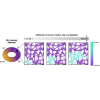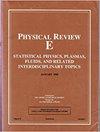在易变神经回路模型中对确定性进行稳健编码
IF 2.4
3区 物理与天体物理
Q1 Mathematics
引用次数: 0
摘要
局部持续神经活动可以编码连续变量的延迟估计值。常见的实验要求受试者在延迟后存储并报告特定线索(如屏幕上的定向条)的特征值(如方向)。将记录到的神经元活动沿着其特征调谐进行可视化,就会发现活动凸起,其中心随机游走,随着时间的推移而降低估计值。因此,凹凸位置代表了记忆中的估计值。最近的研究表明,凹凸振幅可能代表了估计的确定性,反映了贝叶斯后验的概率群体代码。由于在动态系统中构建连续吸引子时常见的微调,这种类型的理想化模型非常脆弱。在这里,我们通过扩展神经回路模型,将量化非线性因素纳入其中,提出了另一种稳健地支持多重碰撞振幅的可变模型。电路活动的渐近投影产生了凹凸解的振幅和位置的低维演化方程,以响应外部刺激和噪声扰动。对简化方程的分析准确地描述了相位差和稳定离散值之间振幅过渡的动态。更突出的线索会产生更高的振幅和更小的漂移,这与实验显示确定性与更准确记忆的相关性是一致的。本文章由计算机程序翻译,如有差异,请以英文原文为准。

Robustly encoding certainty in a metastable neural circuit model
Localized persistent neural activity can encode delayed estimates of continuous variables. Common experiments require that subjects store and report the feature value (e.g., orientation) of a particular cue (e.g., oriented bar on a screen) after a delay. Visualizing recorded activity of neurons along their feature tuning reveals activity bumps whose centers wander stochastically, degrading the estimate over time. Bump position therefore represents the remembered estimate. Recent work suggests bump amplitude may represent estimate certainty reflecting a probabilistic population code for a Bayesian posterior. Idealized models of this type are fragile due to the fine tuning common to constructed continuum attractors in dynamical systems. Here we propose an alternative metastable model for robustly supporting multiple bump amplitudes by extending neural circuit models to include quantized nonlinearities. Asymptotic projections of circuit activity produce low-dimensional evolution equations for the amplitude and position of bump solutions in response to external stimuli and noise perturbations. Analysis of reduced equations accurately characterizes phase variance and the dynamics of amplitude transitions between stable discrete values. More salient cues generate bumps of higher amplitude which wander less, consistent with experiments showing certainty correlates with more accurate memories.
求助全文
通过发布文献求助,成功后即可免费获取论文全文。
去求助
来源期刊

Physical review. E
物理-物理:流体与等离子体
CiteScore
4.60
自引率
16.70%
发文量
0
审稿时长
3.3 months
期刊介绍:
Physical Review E (PRE), broad and interdisciplinary in scope, focuses on collective phenomena of many-body systems, with statistical physics and nonlinear dynamics as the central themes of the journal. Physical Review E publishes recent developments in biological and soft matter physics including granular materials, colloids, complex fluids, liquid crystals, and polymers. The journal covers fluid dynamics and plasma physics and includes sections on computational and interdisciplinary physics, for example, complex networks.
 求助内容:
求助内容: 应助结果提醒方式:
应助结果提醒方式:


